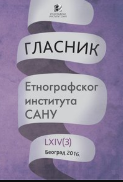Инклузија слепих и слабовидих особа у програмске активности музеја на отвореном – пример пројектa Тактилна баштина
Inclusion of Blind and Visually Impaired People into Program Activities of the Open-Air Museum – Case Study Tactile Heritage
Author(s): Bojana BogdanovićSubject(s): Law, Constitution, Jurisprudence, Museology & Heritage Studies, Media studies, Cultural Anthropology / Ethnology, Present Times (2010 - today), Inclusive Education / Inclusion
Published by: Етнографски институт САНУ
Keywords: inclusion; people with disabilities; open-air museums;
Summary/Abstract: The paper featuring the project Tactile Heritage, implemented in 2015 at the Open-air Museum “Old Village” in Sirogojno, revises the process of inclusion of blind and visually impaired people in the program activities of the open-air museum. The current museum practice in Serbia shows that insufficient attention is paid to the groups of people for whom the museum activities are partially (or fully) (un)avaliable and those who do not take part in museum activities (by their or other people's will). The aim of the paper is to draw attention to the possibilities of improving availability and quality of museum content to people with disabilities. However, due to the studious presentation, the paper provides general overview of the legal and statutory regulations as well as specific and important concepts that are key to the system of general museology, which in their totality contribute to the improvement of modern museum practice. In accordance with the principles of new museology that attempts to break the two-century long tradition of exclusivity and elitism of museological work, the project Tactile Heritage demonstrates that the museum communication can (and must) balance between the peculiarities and constraints of users as well as specificities and possibilities of the new media.
Journal: Гласник Етнографског института САНУ
- Issue Year: LXV/2017
- Issue No: 1
- Page Range: 163-175
- Page Count: 13
- Language: Serbian

